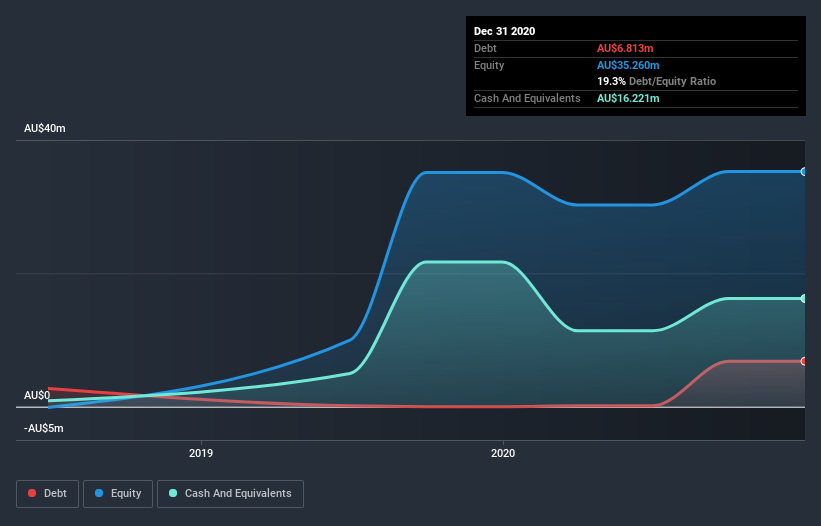Legendary fund manager Li Lu (who Charlie Munger backed) once said, 'The biggest investment risk is not the volatility of prices, but whether you will suffer a permanent loss of capital.' It's only natural to consider a company's balance sheet when you examine how risky it is, since debt is often involved when a business collapses. As with many other companies Mighty Craft Limited (ASX:MCL) makes use of debt. But is this debt a concern to shareholders?
When Is Debt A Problem?
Debt assists a business until the business has trouble paying it off, either with new capital or with free cash flow. If things get really bad, the lenders can take control of the business. However, a more common (but still painful) scenario is that it has to raise new equity capital at a low price, thus permanently diluting shareholders. Of course, the upside of debt is that it often represents cheap capital, especially when it replaces dilution in a company with the ability to reinvest at high rates of return. The first thing to do when considering how much debt a business uses is to look at its cash and debt together.
Check out our latest analysis for Mighty Craft
What Is Mighty Craft's Debt?
You can click the graphic below for the historical numbers, but it shows that as of December 2020 Mighty Craft had AU$6.81m of debt, an increase on none, over one year. But on the other hand it also has AU$16.2m in cash, leading to a AU$9.41m net cash position.

How Strong Is Mighty Craft's Balance Sheet?
According to the last reported balance sheet, Mighty Craft had liabilities of AU$7.70m due within 12 months, and liabilities of AU$20.5m due beyond 12 months. On the other hand, it had cash of AU$16.2m and AU$3.49m worth of receivables due within a year. So it has liabilities totalling AU$8.44m more than its cash and near-term receivables, combined.
Given Mighty Craft has a market capitalization of AU$45.7m, it's hard to believe these liabilities pose much threat. However, we do think it is worth keeping an eye on its balance sheet strength, as it may change over time. While it does have liabilities worth noting, Mighty Craft also has more cash than debt, so we're pretty confident it can manage its debt safely. When analysing debt levels, the balance sheet is the obvious place to start. But it is Mighty Craft's earnings that will influence how the balance sheet holds up in the future. So if you're keen to discover more about its earnings, it might be worth checking out this graph of its long term earnings trend.
In the last year Mighty Craft wasn't profitable at an EBIT level, but managed to grow its revenue by 131%, to AU$16m. So there's no doubt that shareholders are cheering for growth
So How Risky Is Mighty Craft?
We have no doubt that loss making companies are, in general, riskier than profitable ones. And in the last year Mighty Craft had an earnings before interest and tax (EBIT) loss, truth be told. And over the same period it saw negative free cash outflow of AU$16m and booked a AU$11m accounting loss. While this does make the company a bit risky, it's important to remember it has net cash of AU$9.41m. That means it could keep spending at its current rate for more than two years. Importantly, Mighty Craft's revenue growth is hot to trot. High growth pre-profit companies may well be risky, but they can also offer great rewards. There's no doubt that we learn most about debt from the balance sheet. But ultimately, every company can contain risks that exist outside of the balance sheet. For instance, we've identified 4 warning signs for Mighty Craft (1 makes us a bit uncomfortable) you should be aware of.
Of course, if you're the type of investor who prefers buying stocks without the burden of debt, then don't hesitate to discover our exclusive list of net cash growth stocks, today.
If you decide to trade Mighty Craft, use the lowest-cost* platform that is rated #1 Overall by Barron’s, Interactive Brokers. Trade stocks, options, futures, forex, bonds and funds on 135 markets, all from a single integrated account. Promoted
New: Manage All Your Stock Portfolios in One Place
We've created the ultimate portfolio companion for stock investors, and it's free.
• Connect an unlimited number of Portfolios and see your total in one currency
• Be alerted to new Warning Signs or Risks via email or mobile
• Track the Fair Value of your stocks
This article by Simply Wall St is general in nature. It does not constitute a recommendation to buy or sell any stock, and does not take account of your objectives, or your financial situation. We aim to bring you long-term focused analysis driven by fundamental data. Note that our analysis may not factor in the latest price-sensitive company announcements or qualitative material. Simply Wall St has no position in any stocks mentioned.
*Interactive Brokers Rated Lowest Cost Broker by StockBrokers.com Annual Online Review 2020
Have feedback on this article? Concerned about the content? Get in touch with us directly. Alternatively, email editorial-team (at) simplywallst.com.
About ASX:MCL
Mighty Craft
Engages in the acquisition and operation of various breweries, distilleries, bars, and restaurants in Australia.
Slight and slightly overvalued.
Similar Companies
Market Insights
Community Narratives



